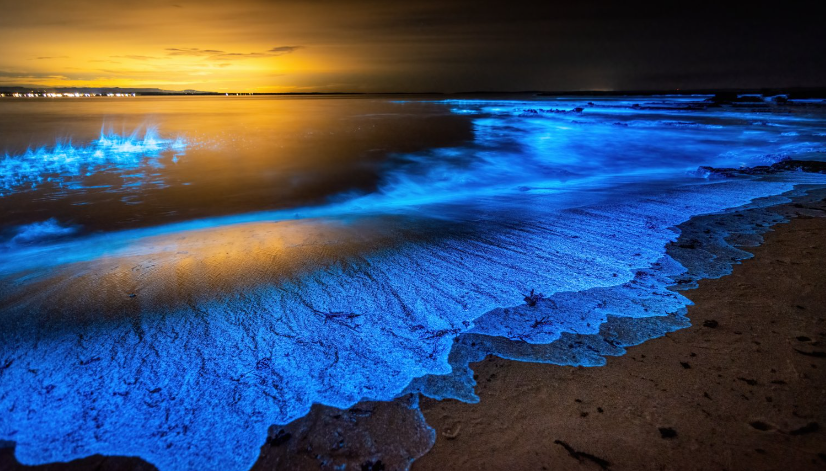What is Bioluminescence?
Bioluminescence is a fascinating natural phenomenon that occurs when living organisms produce and emit light. This light is generated through a chemical reaction that involves a light-emitting molecule called luciferin and an enzyme called luciferase. When luciferin reacts with oxygen, catalyzed by luciferase, light is produced. This biochemical emission of light is found in various organisms, including some species of bacteria, algae, jellyfish, worms, insects (such as fireflies), and fish.
Bioluminescence serves various purposes in nature, depending on the organism. For example, it can be used to warn or deter predators, attract mates, lure prey, or communicate. The light emitted can range in color from green, blue, to red, with blue and green being the most common colors. This is because these colors have shorter wavelengths, which travel further in water, an environment where many bioluminescent organisms are found.
The phenomenon of bioluminescence is not only a subject of scientific research but also a source of natural beauty and fascination. It contributes to the mysterious and enchanting scenes observed in the depths of the oceans and in various terrestrial environments.
Types of Bioluminescence
Bioluminescence manifests in diverse environments, spanning terrestrial, marine, and fungal domains. Each type showcases unique organisms that utilize bioluminescence for various ecological functions, from communication and predation to mating and defense.
Terrestrial Bioluminescence: Glowworms and Fireflies
In terrestrial habitats, bioluminescence is perhaps most enchantingly displayed by glowworms and fireflies. Glowworms, which are not worms but the larval stage of a beetle, emit a soft light from their abdomen to attract prey into their sticky webs. Fireflies, or lightning bugs, are beetles that use bioluminescence to communicate and find mates. Male fireflies flash specific light patterns to attract females, who respond with flashes of their own. This light is typically yellow, green, or pale red.
Marine Bioluminescence: Jellyfish, Algae, and More
Marine environments are the most common realms for bioluminescent organisms, ranging from the surface of the ocean to its darkest depths. Jellyfish use bioluminescence as a defense mechanism, producing a sudden flash of light to startle predators and escape harm. Dinoflagellates, a type of planktonic algae, create a glowing effect when disturbed by waves or passing boats, a phenomenon often seen in warm coastal waters, known as “sea sparkle.” Deep-sea creatures, including some species of squid, fish, and shrimp, emit light to camouflage, attract prey, or communicate in the dark, lightless depths of the ocean.
Fungal Bioluminescence: The Glow of Mushrooms
Fungal bioluminescence is a mesmerizing spectacle found in certain species of mushrooms. This glow, often greenish, is thought to attract insects that can help disperse the fungi’s spores, aiding in their reproduction. Bioluminescent fungi are found in various parts of the world, including North and South America, Australia, and Asia, illuminating the forest floor and decaying wood with their eerie light.
Where to Witness Bioluminescence
Top Destinations for Bioluminescent Experiences
1. Mosquito Bay, Vieques, Puerto Rico
Mosquito Bay is renowned for its extremely high concentration of bioluminescent dinoflagellates, making it one of the brightest bioluminescent bays in the world. Visitors can take night-time kayak tours to see the water glow with every movement.
2. Toyama Bay, Japan
Toyama Bay is famous for its annual springtime spectacle of bioluminescent firefly squid. These small squids emit a blue light and can be seen in large numbers, creating a stunning underwater light show near the surface of the bay.
3. Waitomo Glowworm Caves, New Zealand
The Waitomo Caves offer a unique terrestrial bioluminescent experience with thousands of glowworms (Arachnocampa luminosa) illuminating the cave ceilings. Tours through these caves reveal a starry sky-like illusion underground.
4. Vaadhoo Island, Maldives
The “Sea of Stars” phenomenon on Vaadhoo Island is caused by bioluminescent plankton that lights up the beach at night. This breathtaking scene looks like a mirror reflection of the starry sky on the water’s surface.
5. Manasquan Beach, New Jersey, USA
During warmer months, bioluminescent dinoflagellates can be seen glowing in the waves along the Jersey Shore, including Manasquan Beach. Night swimmers and kayakers often enjoy this natural light show.
6. Tomales Bay, California, USA
Tomales Bay, located north of San Francisco, is another spot where bioluminescent algae can create a glowing effect in the water, especially during the summer and fall. Kayaking tours at night offer a peaceful way to experience this phenomenon.
7. Luminous Lagoon, Jamaica
The Luminous Lagoon is one of the brightest bioluminescent bays in the world, located near Falmouth, Jamaica. Boat tours after dark allow visitors to swim and interact with the glowing waters, illuminated by millions of microorganisms.
8. Bahía de Fosforescente, La Parguera, Puerto Rico
Another bioluminescent bay in Puerto Rico, Bahía de Fosforescente in La Parguera, offers boat tours and the chance to swim in waters that light up due to the movement of bioluminescent organisms.
Tips for Observing Bioluminescence in the Wild
1. Choose the Right Time
- Moon Phase: A new moon or a night with minimal moonlight enhances the visibility of bioluminescence. Avoid full moon nights as the extra light can make it harder to see.
- Season: Research the best season for bioluminescence at your chosen destination, as some organisms only glow during certain times of the year.
2. Select the Right Location
- Research well-known spots for bioluminescence, such as beaches, bays, or forests known for their bioluminescent organisms.
- Remote areas away from city lights offer the best visibility.
3. Be Patient and Let Your Eyes Adjust
- It may take up to 30 minutes for your eyes to fully adjust to the dark. Be patient and give yourself time to adapt to the low-light conditions.
4. Minimize Light Pollution
- Avoid using flashlights or phone lights, as they can disrupt your night vision. If you need a light, use a red light which is less likely to affect your ability to see the bioluminescence.
- Try to visit areas away from artificial lights to experience the full effect of the natural glow.
5. Move Gently
- In water environments, gentle movements can stimulate bioluminescent organisms and increase their glow. If you’re in a boat or kayak, paddle softly.
- If you’re swimming, move slowly and watch as the water around you lights up.
6. Respect the Environment
- Follow local guidelines and respect wildlife. Avoid touching or disturbing the bioluminescent organisms.
- If swimming, avoid using sunscreen or lotions that could harm the microorganisms.
7. Use a Camera with Manual Settings
- If you want to capture the moment, use a camera that allows manual adjustments to shutter speed, ISO, and aperture. Long exposures are usually required to photograph bioluminescence.
8. Join a Guided Tour
- Consider booking a guided tour, especially if it’s your first time visiting a bioluminescent site. Experienced guides can offer insights and take you to the best spots.
9. Dress Appropriately
- Nights can get cool, especially near the water. Wear warm clothing and consider waterproof gear if you plan to be near or in the water.
10. Manage Expectations
- Bioluminescence can vary in intensity. Factors such as water temperature, time of year, and the presence of nutrients can affect its visibility.


